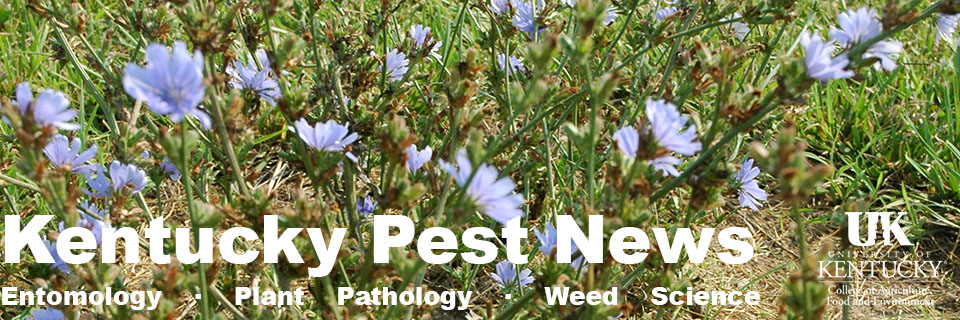Disease levels have been relatively low in tobacco float beds during the past few weeks, and the transplant crop seems to be a bit behind schedule compared to last year. We’ve observed a fair amount of Rhizoctonia damping-off at this…
Monthly Archives: April 2014
Managing Corn Earworm in Sweet Corn
If we consider acreage, sweet corn is our most widely grown vegetable in Kentucky. Locally-grown sweet corn is very popular, and in some ways, the first local sweet corn of the year signals the start of summer. While many people…
Calico Scale Can Be a Nemesis of Landscape Trees
Scale insects are often overlooked sap-feeding insects that can be serious pests of shade and ornamental trees. The calico scale (Figure1), a soft scale, has caused significant problems in Kentucky, especially for maples, sweetgum, honey locust, Japanese Zelkova, crabapples, and…
Black Flies
Black flies or buffalo gnats (Figure 1) are 1/8-inch long hump-backed dark flies with wide, clear wings. Females use their sharp blade-like mouthparts to slice the skin and feed on blood that wells up. The bite may bleed for some…
Plant Disease Diagnostic Lab Highlights
The following plant disease highlights from the UK Plant Disease Diagnostic Laboratories represent recent sample submissions from field crops, fruit and vegetables, and ornamentals. Pythium root rot was diagnosed on tobacco transplants, as well as non-infectious problems of uneven germination,…
2014 Insect Trap Counts
Weekly trap counts for major insect pests are provided by the Kentucky IPM Program. Traps are located at the UK Research Center in western Kentucky and the UK Spindletop Farm in Lexington. Below are trap counts for the current period.…
Alfalfa Weevil Season Begins
A few newly hatched alfalfa weevil larvae were found in Fayette County alfalfa late last week, but tip feeding was not evident. Degree day accumulations are reaching totals where feeding damage should become apparent soon if the insect is at…
2014 Wheat Fungicide Efficacy Table
Each year, the North Central Regional Committee on Management of Small Grain Diseases (NCERA-184) revises and disseminates a fungicide efficacy table. Efficacy ratings for each fungicide listed in Table 1 were determined by field testing fungicides over several years and…
Variegated Cutworms and Fungus Gnats: Common Tobacco Plant Bed Pests
Variegated cutworm moths can enter greenhouses and float bed structures to lay eggs on developing tobacco transplants. A female moth lays clusters of about 60 eggs. The dark cutworm larvae feed for about 4 weeks and are about 1 ½…
Boxwood Psyllids
Psyllids are flat, green, sap-feeding insects that cause spring terminal growth to cup. The damage is especially noticeable on American boxwood. While the small nymphs blend well with the foliage, the white waxy strands that they produce are very easy…
Eastern Tent Caterpillars Becoming Apparent
Eastern tent caterpillars (ETC) are easy to spot now in wild cherry and related trees. Most tents on limbs now range from softball- to football-size. As the caterpillars grow, they will begin to leave the small tents on limbs to…
Ticks
Ticks are climbing on low growing vegetation in and along trails in wooded areas as they seek their first blood meal of the year. Many tick species can carry diseases. Fortunately, the incidence of tick-borne diseases in Kentucky is low.…
Plant Disease Diagnostic Lab Highlights
The following plant disease highlights from the UK Plant Disease Diagnostic Laboratories represent recent sample submissions from field crops, fruit and vegetables, and ornamentals. Agronomic samples included wheat soilborne mosaic virus on wheat; and Rhizoctonia damping-off on tobacco transplants. On…
2014 Insect Trap Counts
Weekly trap counts for major insect pests are provided by the Kentucky IPM Program. Traps are located at the UK Research Center in western Kentucky and the UK Spindletop Farm in Lexington. Below are trap counts for the current period.…
On-Farm Stored Grain Fumigation Workshop
The University of Kentucky Grain Science Working Group will be offering a Grain Storage Fumigation Workshop on Tuesday, May 13, 2014 from 1:00 PM to 4:30 PM CDT, at the UK-Research and Education Center (REC) in Princeton, KY. This workshop…
